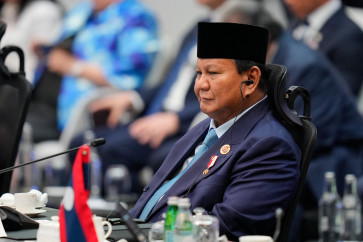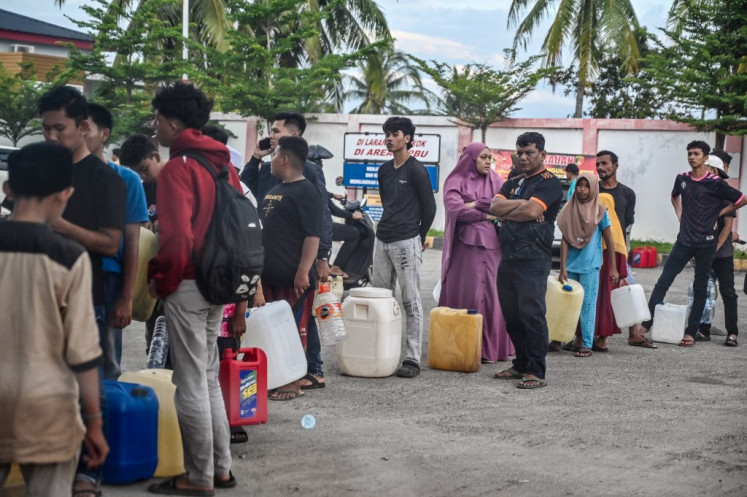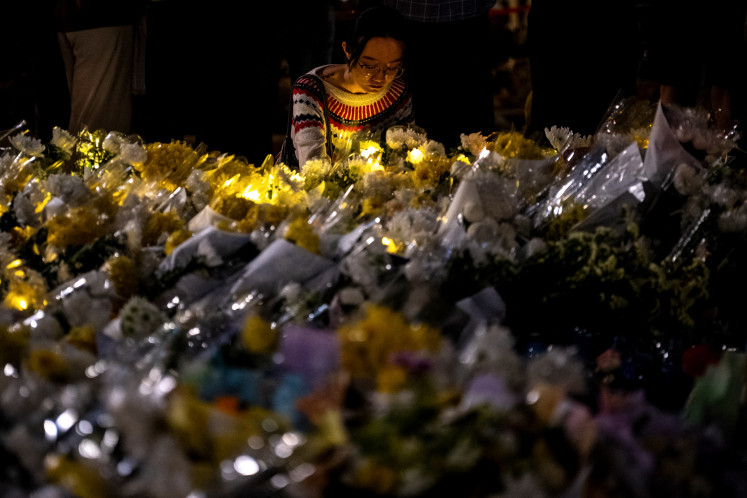Popular Reads
Top Results
Can't find what you're looking for?
View all search resultsPopular Reads
Top Results
Can't find what you're looking for?
View all search resultsRI struggles to conquer haze crisis
Despite the governmentâs pledge of all-out recovery efforts, land and forest fires have continued to rage in many regions in Sumatra and Kalimantan, leaving local residents to struggle with thick haze that puts their health at risk and the education and transportation sectors in jeopardy
Change text size
Gift Premium Articles
to Anyone
D
espite the government's pledge of all-out recovery efforts, land and forest fires have continued to rage in many regions in Sumatra and Kalimantan, leaving local residents to struggle with thick haze that puts their health at risk and the education and transportation sectors in jeopardy.
In Riau, the country's largest oil-producing region, a high intensity of smoke blanketed many parts of the province on Monday despite the absence of hot spots indicating land and forest fires in the province since a day earlier.
Head of the Meteorology, Climatology and Geophysics Agency's (BMKG) Pekanbaru station, Sugarin, said of the 285 hot spots detected on Monday in Sumatra, 239 had been spotted in South Sumatra, 29 in Bangka-Belitung and 17 in Lampung.
'The deteriorating air quality in Riau is triggered by haze produced by the remaining forest and land fires in a number of our neighboring provinces,' Sugarin said.
In the provincial capital of Pekanbaru, visibility was recorded at 100 meters on Monday morning. Indragiri Hulu and Pelalawan regencies shared the same level of visibility at 200 meters while Dumai municipality recorded slightly better visibility at 500 meters.
Data at the Riau haze disaster emergency post showed that, as of Monday, the air pollutant standard index (PSI) in the four regions of Pekanbaru, Kampar, Siak and Rokan Hilir stood at 'dangerous', with Pekanbaru recording the highest level of air pollution with 858 PSI.
According to the government's existing guidelines, air quality is considered 'healthy' if the pollutant level stands below 50 PSI, 'moderate' when the level stands between 51 and 100 PSI, 'unhealthy' between 101 and 199 PSI, 'very unhealthy' between 200 and 299 PSI and 'dangerous' when it surpasses 300 PSI.
In response to the worsening haze, the Pekanbaru Education Agency on Monday decided to again temporarily shut schools until Wednesday after resuming classes on Friday and Saturday.
'It's better for the children to stay at home amid thick and dangerous haze like at present,' agency head Zulfadil said.
Over the past weeks, air pollution from fires in peatland and plantations has severely affected several regions in Sumatra and Kalimantan, including Jambi, Riau, South Sumatra, West Sumatra and Central Kalimantan.
The ongoing crisis has also been exacerbated by this year's prolonged dry season, caused by the El Niño weather phenomenon.
Soon after his inauguration on Sept. 9, the new chief of the National Disaster Mitigation Agency (BNPB), Willem Rampangilei, said the agency would aim to clear up the haze blanketing Sumatra in two weeks.
Among indicators of success, he said, would be airports in the regions operating normally without disruptions from haze, sending students back to school and reducing symptoms of acute respiratory infections (ISPA).
Approaching the end of the month, however, the government-led recovery efforts have shown little progress, as the number of fires detected remains fluctuating.
In West Sumatra, the Dharmasraya regional administration also decided to halt school activities on Monday as the air quality in the region stood at a 'dangerous' level over the past three days.
'We decided to take the measure to help students avoid the impacts of haze on their health,' Dharmasraya Education, Youth and Sports Agency secretary Sutadi said on Monday, as quoted by Antara news agency.
Thick haze has also cost thousands of air travelers time and money.
Ria Permana Sari, 28, a Pekanbaru resident, said she had had to travel overland to Padang, West Sumatra, to get a flight to Jakarta since all flights from Pekanbaru's Sultan Syarif Kasim (SKK) II International Airport to the nation's capital had been canceled since Saturday because of poor visibility.
'Many passengers have been forced to travel overland to Padang to fly to Jakarta. For this, we have to spend an extra Rp 150,000 [US$10.10] for the trip, which takes six hours from Pekanbaru,' she said, as quoted by Antara.
Meanwhile, in Palangkaraya, Central Kalimantan, the local Health Agency said the extraordinary occurrence status for ISPA in the city had entered a third week.
The agency's disaster and endemic section head Fransiska said 759 people had visited local community health centers (Puskesmas) throughout last week for ISPA treatment despite the long weekend for Idul Adha (the Islamic Day of Sacrifice).
'If there was no holiday, the number of patients coming to Puskesmas for ISPA treatments last week for sure would have been higher than 759,' she said.
_________________________________
To receive comprehensive and earlier access to The Jakarta Post print edition, please subscribe to our epaper through iOS' iTunes, Android's Google Play, Blackberry World or Microsoft's Windows Store. Subscription includes free daily editions of The Nation, The Star Malaysia, the Philippine Daily Inquirer and Asia News.
For print subscription, please contact our call center at (+6221) 5360014 or subscription@thejakartapost.com










